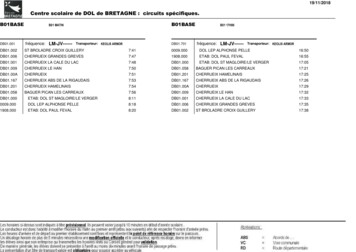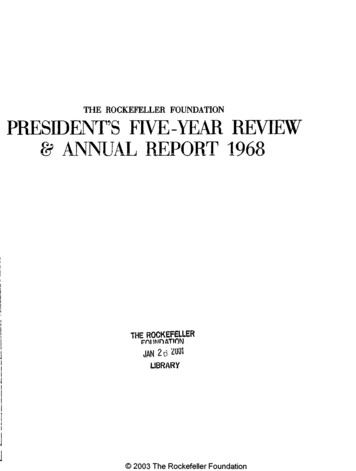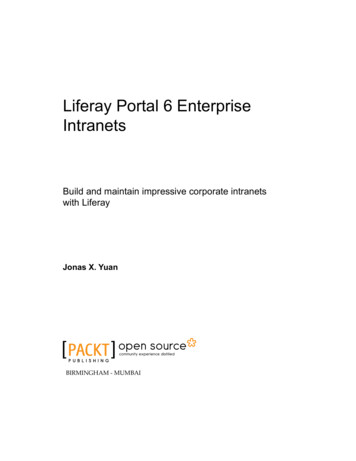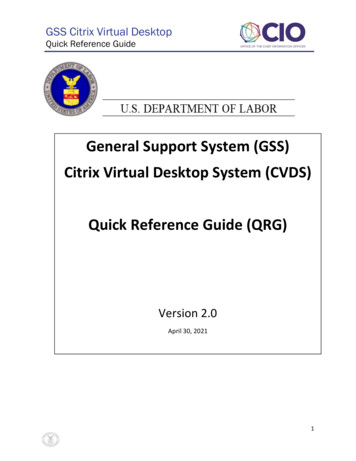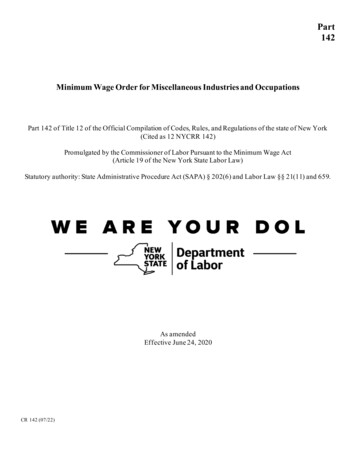
Transcription
Part142Minimum Wage Order for Miscellaneous Industries and OccupationsPart 142 of Title 12 of the Official Compilation of Codes, Rules, and Regulations of the state of New York(Cited as 12 NYCRR 142)Promulgated by the Commissioner of Labor Pursuant to the Minimum Wage Act(Article 19 of the New York State Labor Law)Statutory authority: State Administrative Procedure Act (SAPA) § 202(6) and Labor Law §§ 21(11) and 659.As amendedEffective June 24, 2020CR 142 (07/22)
PART 142MISCELLANEOUS INDUSTRIES AND OCCUPATIONSSubpart 142-1 CoverageSubpart 142-2 Provisions Applicable to All Employees Subject to This Part, Except Employees inNonprofitmaking Institutions Covered by the Provisions of Subpart 142-3Subpart 142-3 Provisions Applicable to Employee in Nonprofitmaking Institutions Which Have NotElected to be Exempt from Coverage Under a Minimum Wage OrderSUBPART 142-1COVERAGESec.142-1.1Coverage of Part.§ 142-1.1 Coverage of PartThis Part shall apply to all employees, as such term is defined in this Part, except:(a) employees who are covered by minimum wage standards in any other minimum wage order promulgatedby the commissioner; and(b) employees of a nonprofitmaking institution which has elected to be exempt from coverage under aminimum wage order, pursuant to subdivision 3 of section 652 of the Minimum Wage Act.SUBPART 142-2PROVISIONS APPLICABLE TO ALL EMPLOYEES SUBJECT TO THIS PART, EXCEPTEMPLOYEES IN NONPROFITMAKING INSTITUTIONS COVERED BY THE PROVISIONS OFSUBPART 2.13142-2.14142-2.15142-2.16142-2.17Basic minimum hourly wage rate and allowancesOvertime rateCall-in payAdditional rate for split shift and spread of hoursAllowancesREGULATIONSEmployer recordsStatement to employeePostingBasis of wage paymentDeductions and expensesStudent obtaining vocational experienceLearner and apprentice ratesRehabilitation programsDEFINITIONSEmployeeVoluntary absenceRegular rateSplit shift
read of hoursMealLodgingTipsRequired uniformStudent§ 142-2.1 Basic minimum hourly wage rate and allowances.(a) The basic minimum hourly wage rate shall be, for each hour worked in:(1) New York City for(i) Large employers of eleven or more employees 11.00 per hour on and after December 31, 2016; 13.00 per hour on and after December 31, 2017; 15.00 per hour on and after December 31, 2018;(ii) Small employers of ten or fewer employees 10.50 per hour on and after December 31, 2016; 12.00 per hour on and after December 31, 2017; 13.50 per hour on and after December 31, 2018; 15.00 per hour on and after December 31, 2019;(2) Remainder of downstate (Nassau, Suffolk and Westchester counties) 10.00 per hour on and after December 31, 2016; 11.00 per hour on and after December 31, 2017; 12.00 per hour on and after December 31, 2018; 13.00 per hour on and after December 31, 2019; 14.00 per hour on and after December 31, 2020; 15.00 per hour on and after December 31, 2021,(3) Remainder of state (outside of New York City and Nassau, Suffolk and Westchester counties) 9.70 per hour on and after December 31, 2016; 10.40 per hour on and after December 31, 2017; 11.10 per hour on and after December 31, 2018; 11.80 per hour on and after December 31, 2019; 12.50 per hour on and after December 31, 2020; 13.20 per hour on and after December 31, 2021.(4) If a higher wage is established by Federal law pursuant to 29 U.S.C. section206 or its successors,such wage shall apply.(b) The minimum wage shall be paid for the time an employee is permitted to work, or is required to beavailable for work at a place prescribed by the employer, and shall include time spent in traveling to the extentthat such traveling is part of the duties of the employee. However, a residential employee--one who lives on thepremises of the employer--shall not be deemed to be permitted to work or required to be available for work: (1)during his or her normal sleeping hours solely because he is required to be on call during such hours; or (2) at
any other time when he or she is free to leave the place of employment. Notwithstanding the above, thissubdivision shall not be construed to require that the minimum wage be paid for meal periods and sleep timesthat are excluded from hours worked under the Fair Labor Standards Act of 1938, as amended, in accordancewith sections 785.19 and 785.22 of 29 C.F.R. for a home care aide who works a shift of 24 hours or more.§ 142-2.2 Overtime rate.An employer shall pay an employee for overtime at a wage rate of one and one-half times the employee'sregular rate in the manner and methods provided in and subject to the exemptions of sections 7 and 13 of 29USC 201 et seq., the Fair Labor Standards Act of 1938, as amended, provided, however, that the exemptions setforth in section 13(a)(2) and (4) shall not apply. In addition, an employer shall pay employees subject to theexemptions of section 13 of the Fair Labor Standards Act, as amended, except employees subject to section13(a)(2) and (4) of such act, overtime at a wage rate of one and one-half times the basic minimum hourly rate.The Fair Labor Standards Act is published in the United States Code, the official compilation of Federalstatutes, by the Government Printing Office, Washington, DC. Copies of the Fair Labor Standards Act areavailable at the following office:New York State Department of LaborCounsel's OfficeState Office Building Campus,Building 12, Room 509Albany, NY 12240-0005The applicable overtime rate shall be paid for each workweek:For working time overNon-residential Residentialemployeesemployees40 hours44 hours§ 142-2.3 Call-in pay.An employee who by request or permission of the employer reports for work on any day shall be paid for atleast four hours, or the number of hours in the regularly scheduled shift, whichever is less, at the basic minimumhourly wage.§ 142-2.4 Additional rate for split shift and spread of hours.An employee shall receive one hour's pay at the basic minimum hourly wage rate, in addition to theminimum wage required in this Part for any day in which:(a) the spread of hours exceeds 10 hours; or(b) there is a split shift; or(c) both situations occur.
§ 142-2.5 Allowances.(a) Allowances for meals, lodging and utilities. (1) Meals and lodging furnished by an employer to anemployee may be considered a part of the minimum wage, but shall be valued at not more than:(i) Meals, for work performed in(a) New York City for(1) Large employers of eleven or more employees 3.80 per meal on and after December 31, 2016; 4.50 per meal on and after December 31, 2017; 5.15 per meal on and after December 31, 2018;(2) Small employers of ten or fewer employees 3.60 per meal on and after December 31, 2016; 4.15 per meal on and after December 31, 2017; 4.65 per meal on and after December 31, 2018; 5.15 per meal on and after December 31, 2019;(b) Remainder of downstate (Nassau, Suffolk and Westchester counties) 3.45 per meal on and after December 31, 2016; 3.80 per meal on and after December 31, 2017; 4.15 per meal on and after December 31, 2018; 4.50 per meal on and after December 31, 2019; 4.80 per meal on and after December 31, 2020; 5.15 per meal on and after December 31, 2021;(c) Remainder of state (outside of New York City, Nassau, Suffolk and Westchester counties) 3.35 per meal on and after December 31, 2016; 3.60 per meal on and after December 31, 2017; 3.80 per meal on and after December 31, 2018; 4.05 per meal on and after December 31, 2019; 4.30 per meal on and after December 31, 2020; 4.55 per meal on and after December 31, 2021.(ii) Lodging, for work performed in(a) New York City for(1) Large employers of eleven or more employees 4.65 per day on and after December 31, 2016; 5.50 per day on and after December 31, 2017; 6.35 per day on and after December 31, 2018;
(2) Small employers of ten or fewer employees 4.45 per day on and after December 31, 2016; 5.05 per day on and after December 31, 2017; 5.70 per day on and after December 31, 2018; 6.35 per day on and after December 31, 2019;(b) Remainder of downstate (Nassau, Suffolk and Westchester counties) 4.20 per day on and after December 31, 2016; 4.65 per day on and after December 31, 2017; 5.05 per day on and after December 31, 2018; 5.50 per day on and after December 31, 2019; 5.90 per day on and after December 31, 2020; 6.35 per day on and after December 31, 2021;(c) Remainder of state (outside of New York City, Nassau, Suffolk and Westchester counties) 4.10 per day on and after December 31, 2016; 4.40 per day on and after December 31, 2017; 4.70 per day on and after December 31, 2018; 5.00 per day on and after December 31, 2019; 5.30 per day on and after December 31, 2020; 5.60 per day on and after December 31, 2021.(2) When a house or apartment and utilities are furnished by an employer to an employee, a fair andreasonable amount may be allowed for such facilities, which amount shall not exceed the lesser of either thevalue of prevailing rentals in the locality for comparable facilities, or the following amounts, for workperformed in(i) New York City for(a) Large employers of eleven or more employees 8.80 per day on and after December 31, 2016; 10.40 per day on and after December 31, 2017; 12.00 per day on and after December 31, 2018;(b) Small employers of ten or fewer employees 8.40 per day on and after December 31, 2016; 9.60 per day on and after December 31, 2017; 10.80 per day on and after December 31, 2018; 12.00 per day on and after December 31, 2019;(ii) Remainder of downstate (Nassau, Suffolk and Westchester counties) 8.00 per day on and after December 31, 2016; 8.80 per day on and after December 31, 2017; 9.60 per day on and after December 31, 2018; 10.40 per day on and after December 31, 2019; 11.20 per day on and after December 31, 2020;
12.00 per day on and after December 31, 2021;(iii) Remainder of state (outside of New York City, Nassau, Suffolk and Westchester counties) 7.75 per day on and after December 31, 2016; 8.30 per day on and after December 31, 2017; 8.90 per day on and after December 31, 2018; 9.45 per day on and after December 31, 2019; 10.00 per day on and after December 31, 2020; 10.55 per day on and after December 31, 2021.(b) Allowances for tips. (1) Tips, or gratuities, may be considered a part of the minimum wage, subject tothe following conditions:(i) the particular occupation in which the employee is engaged is one in which tips have customarilyand usually constituted a part of the employee's remuneration;(ii) substantial evidence is provided that the employee received in tips at least the amount of theallowance claimed. An example of substantial evidence is a statement signed by the employee that heactually received in tips the amount of the allowance claimed; and(iii) the allowance claimed by the employer is recorded on a weekly basis as a separate item in thewage record.(2) Allowances for tips.*(i) Allowances for tips shall not exceed the Low tip amount listed below for an employee whoseweekly average of tips received is between such Low tip amount and the High tip amount listed below,and shall not exceed such High tip amount for an employee whose weekly average of tips receivedequals or exceeds such High tip amount, for work performed in:(a) New York City for(1) Large employers of eleven or more employees 1.65 Low, 2.70 High on and after December 31, 2016; 1.95 Low, 3.20 High on and after December 31, 2017; 2.25 Low, 3.65 High on and after December 31, 2018;(2) Small employers of ten or fewer employees 1.60 Low, 2.55 High on and after December 31, 2016; 1.80 Low, 2.95 High on and after December 31, 2017; 2.05 Low, 3.30 High on and after December 31, 2018; 2.25 Low, 3.65 High on and after December 31, 2019;(b) Remainder of downstate (Nassau, Suffolk and Westchester counties) 1.50 Low, 2.45 High on and after December 31, 2016; 1.65 Low, 2.70 High on and after December 31, 2017;
1.80 Low, 2.95 High on and after December 31, 2018; 1.95 Low, 3.20 High on and after December 31, 2019; 2.10 Low, 3.40 High on and after December 31, 2020; 2.25 Low, 3.65 High on and after December 31, 2021,(c) Remainder of state (outside of New York City, Nassau, Suffolk and Westchester counties) 1.45 Low, 2.35 High on and after December 31, 2016; 1.55 Low, 2.55 High on and after December 31, 2017; 1.65 Low, 2.70 High on and after December 31, 2018; 1.75 Low, 2.90 High on and after December 31, 2019; 1.90 Low, 3.05 High on and after December 31, 2020; 2.00 Low, 3.20 High on and after December 31, 2021.(ii) No allowance for tips or gratuities shall be permitted for an employee whose weekly average oftips is less than the applicable Low tip amount listed above in the preceding subparagraph (i) ofparagraph (2) of subdivision (b) of section 142-2.5 of this Subpart.*Beginning December 31, 2020, your employer must pay the full applicable minimum wage rate, andcannot take any tip credit.(c) No allowance for the supply, maintenance or laundering of required uniforms shall be permitted as partof the minimum wage. Where an employee purchases a required uniform, he shall be reimbursed by theemployer for the cost thereof not later than the time of the next payment of wages. Where an employer fails tolaunder or maintain required uniforms for any employee, he shall pay such employee in addition to theminimum wage prescribed herein at the weekly rate set forth below, based on the number of hours worked,where employees who work over 30 hours per week shall be paid the High rate, employees who work more than20 hours but fewer than 30 hours shall be paid the Medium rate and employees who work 20 hours or fewershall be paid the Low rate for work performed in:(1) New York City for(i) Large employers of eleven or more employees 13.70 High, 10.80 Medium, 6.55 Low on and after December 31, 2016; 16.20 High, 12.80 Medium, 7.75 Low on and after December 31, 2017; 18.65 High, 14.75 Medium, 8.90 Low on and after December 31, 2018;(ii) Small employers of ten or fewer employees 13.05 High, 10.35 Medium, 6.25 Low on and after December 31, 2016; 14.95 High, 11.80 Medium, 7.15 Low on and after December 31, 2017; 16.80 High, 13.30 Medium, 8.05 Low on and after December 31, 2018; 18.65 High, 14.75 Medium, 8.90 Low on and after December 31, 2019;(2) Remainder of downstate (Nassau, Suffolk and Westchester counties) 12.45 High, 9.85 Medium, 5.95 Low on and after December 31, 2016;
13.70 High, 10.80 Medium, 6.55 Low on and after December 31, 2017; 14.95 High, 11.80 Medium, 7.15 Low on and after December 31, 2018; 16.20 High, 12.80 Medium, 7.75 Low on and after December 31, 2019; 17.40 High, 13.75 Medium, 8.30 Low on and after December 31, 2020; 18.65 High, 14.75 Medium, 8.90 Low on and after December 31, 2021;(3) Remainder of state (outside of New York City, Nassau, Suffolk and Westchester counties) 12.05 High, 9.55 Medium, 5.75 Low on and after December 31, 2016; 12.95 High, 10.25 Medium, 6.20 Low on and after December 31, 2017; 13.80 High, 10.90 Medium, 6.60 Low on and after December 31, 2018; 14.70 High, 11.60 Medium, 7.00 Low on and after December 31, 2019; 15.55 High, 12.30 Medium, 7.45 Low on and after December 31, 2020; 16.40 High, 13.00 Medium, 7.85 Low on and after December 31, 2021.REGULATIONS§ 142-2.6 Employer records.(a) Every employer shall establish, maintain and preserve for not less than six years, weekly payroll recordswhich shall show for each employee:(1) name and address;(2) social security number;(3) wage rate;(4) the number of hours worked daily and weekly, including the time of arrival and departure of eachemployee working a split shift or spread of hours exceeding 10;(5) when a piece-rate method of payment is used, the number of units produced daily and weekly;(6) the amount of gross wages;(7) deductions from gross wages;(8) allowances, if any, claimed as part of the minimum wage;(9) net wages paid; and(10) student classification.(b) In addition, for each individual permitted to work as a staff counselor in a children's camp, or in anexecutive, administrative or professional capacity, an employer's records shall show:(1) name and address;(2) social security number;
(3) description of occupation; and(4) for individuals working in an executive or administrative capacity, total wages, and the value ofallowances, if any, for each payroll period.(c) For each individual for whom student status is claimed, an employer's records shall contain a statementfrom the school which the student attends, indicating such student:(1) is a student whose course of instruction is one leading to a degree, diploma or certificate; or(2) is required to obtain supervised and directed vocational experience to fulfill curriculumrequirements.(d) Employers, including those who maintain their records containing the information required by thissection at a place outside of New York State, shall make such records or sworn certified copies thereof availableupon request of the commissioner at the place of employment.§ 142-2.7 Statement to employee.Every employer covered by this Part shall furnish to each employee a statement with every payment ofwages, listing hours worked, rates paid, gross wages, allowances, if any, claimed as part of the minimum wage,deductions and net wages.§ 142-2.8 Posting.Every employer covered by this Part shall post in a conspicuous place in his or her establishment a noticeissued by the Department of Labor summarizing minimum wage provisions.§ 142-2.9 Basis of wage payment.The minimum and overtime wage provided by this Part shall be required for each week of work, regardlessof the frequency of payment, whether the wage is on a commission, bonus, piece rate, or any other basis.§ 142-2.10 Deductions and expenses.(a) Wages shall be subject to no deductions, except for allowances authorized in this Part, and except fordeductions authorized or required by law, such as for social security and income tax. Some examples ofprohibited deductions are:(1) deductions for spoilage or breakage;(2) deductions for cash shortages or losses;(3) fines or penalties for lateness, misconduct or quitting by an employee without notice.(b) The minimum wage shall not be reduced by expenses incurred by an employee in carrying out dutiesassigned by an employer.§ 142-2.11 Student obtaining vocational experience.
A student is not deemed to be working or to be permitted to work if, in order to fulfill the curriculumrequirements of the educational institution which such student attends, such student is required to obtainsupervised and directed vocational experience in another establishment.§ 142-2.12 Learner and apprentice rates.No learner or apprentice shall be paid less than the minimum rate prescribed in this Part.§ 142-2.13 Rehabilitation programs.For an individual employed as part of a rehabilitation program approved by the commissioner, the paymentof compensation under such program shall be deemed to meet the requirements of this Part.DEFINITIONS§ 142-2.14 Employee.(a) Employee means any individual employed, suffered or permitted to work by an employer, except asprovided below.(b) Employee does not include any individual employed by a Federal, State or municipal government orpolitical subdivision thereof.(c) Employee also does not include any individual permitted to work in, or as:(1) Baby-sitter; companion.(i) The term baby-sitter means an individual in service as a part-time baby-sitter in the home of theemployer.(ii) The term companion means someone who lives in the home of an employer for the purpose ofserving as a companion to a sick, convalescing or elderly person, and whose principal duties do notinclude housekeeping.(2) Booth renter. The term booth renter means someone who leases or rents space in a beautyestablishment or shop and who operates as an owner or an independent contractor.(3) Labor on a farm. Farm employees are covered under the provisions of the minimum wage order forfarm workers, Part 190 of this Title, promulgated by the Commissioner of Labor pursuant to article 19-A ofthe New York State Labor Law.(4) Executive, administrative or professional capacity.(i) Executive. Work in a bona fide executive capacity means work by an individual:(a) whose primary duty consists of the management of the enterprise in which such individual isemployed or of a customarily recognized department or subdivision thereof;(b) who customarily and regularly directs the work of two or more other employees therein;
(c) who has the authority to hire or fire other employees or whose suggestions andrecommendations as to the hiring or firing and as to the advancement and promotion or any otherchange of status of other employees will be given particular weight;(d) who customarily and regularly exercise discretionary powers; and(e) who is paid for his services a salary, inclusive of board, lodging, or other allowances andfacilities, of not less than the amounts listed below when working in:(1) New York City for(i) Large employers of eleven or more employees 825.00 per week on and after December 31, 2016; 975.00 per week on and after December 31, 2017; 1,125.00 per week on and after December 31, 2018;(ii) Small employers of ten or fewer employees 787.50 per week on and after December 31, 2016; 900.00 per week on and after December 31, 2017; 1,012.50 per week on and after December 31, 2018; 1,125.00 per week on and after December 31, 2019;(2) Remainder of downstate (Nassau, Suffolk and Westchester counties) 750.00 per week on and after December 31, 2016; 825.00 per week on and after December 31, 2017; 900.00 per week on and after December 31, 2018; 975.00 per week on and after December 31, 2019; 1,050.00 per week on and after December 31, 2020; 1,125.00 per week on and after December 31, 2021;(3) Remainder of state (outside of New York City, Nassau, Suffolk and Westchestercounties) 727.50 per week on and after December 31, 2016; 780.00 per week on and after December 31, 2017; 832.00 per week on and after December 31, 2018; 885.00 per week on and after December 31, 2019; 937.50 per week on and after December 31, 2020; 990.00 per week on and after December 31, 2021.(ii) Administrative. Work in a bona fide administrative capacity means work by an individual:(a) whose primary duty consists of the performance of office or nonmanual field work directlyrelated to management policies or general operations of such individual's employer;(b) who customarily and regularly exercises discretion and independent judgment;
(c) who regularly and directly assists an employer, or an employee employed in a bona fideexecutive or administrative capacity (e.g., employment as an administrative assistant); or whoperforms, under only general supervision, work along specialized or technical lines requiring specialtraining, experience or knowledge; and(d) who is paid for his services a salary, inclusive of board, lodging, or other allowances andfacilities, of not less than the amounts listed below when working in:(1) New York City for(i) Large employers of eleven or more employees 825.00 per week on and after December 31, 2016; 975.00 per week on and after December 31, 2017; 1,125.00 per week on and after December 31, 2018;(ii) Small employers of ten or fewer employees 787.50 per week on and after December 31, 2016; 900.00 per week on and after December 31, 2017; 1,012.50 per week on and after December 31, 2018; 1,125.00 per week on and after December 31, 2019;(2) Remainder of downstate (Nassau, Suffolk and Westchester counties) 750.00 per week on and after December 31, 2016; 825.00 per week on and after December 31, 2017; 900.00 per week on and after December 31, 2018; 975.00 per week on and after December 31, 2019; 1,050.00 per week on and after December 31, 2020; 1,125.00 per week on and after December 31, 2021;(3) Remainder of state (outside of New York City, Nassau, Suffolk and Westchestercounties) 727.50 per week on and after December 31, 2016; 780.00 per week on and after December 31, 2017; 832.00 per week on and after December 31, 2018; 885.00 per week on and after December 31, 2019. 937.50 per week on and after December 31, 2020; 990.00 per week on and after December 31, 2021.(iii) Professional. Work in a bona fide professional capacity means work by an individual:(a) whose primary duty consists of the performance of work: requiring knowledge of anadvanced type in a field of science or learning customarily acquired by a prolonged course ofspecialized intellectual instruction and study, as distinguished from a general academic educationand from an apprenticeship, and from training in the performance of routine mental, manual orphysical processes; or original and creative in character in a recognized field of artistic endeavor (asopposed to work which can be produced by a person endowed with general manual or intellectualability and training), and the result of which depends primarily on the invention, imagination ortalent of the employee; and
(b) whose work requires the consistent exercise of discretion and judgment in its performance; or(c) whose work is predominantly intellectual and varied in character (as opposed to routinemental, manual, mechanical or physical work) and is of such a character that the output produced orthe result accomplished cannot be standardized in relation to a given period of time.(5) Outside salesperson. The term outside salesperson means an individual who is customarily andpredominantly engaged away from the premises of the employer and not at any fixed site and location forthe purpose of:(i) making sales;(ii) selling and delivering articles or goods; or(iii) obtaining orders or contracts for service or for the use of facilities.(6) Taxicab driver. The term driver engaged in operating a taxicab means an individual employed todrive an automobile equipped to carry no more than seven passengers, which is used in the business ofcarrying or transporting passengers for hire on a zone or meter fare basis, and the use of which is generallylimited to a community's local transportation needs and which is not operated over fixed routes, or betweenfixed terminals, or under contract.(7) Student in or for a college or university fraternity, sorority, student association or faculty association.A student is not deemed to be an employee if he or she is permitted to work in or for a college or universityfraternity, sorority, student association or faculty association, no part of the net earnings of which inures tothe benefit of any private shareholder or individual, and which is recognized by such college or university.(8) Staff counselor in a children's camp. (i) A staff counselor is a person whose duties primarily relate tothe guidance, instruction, supervision and care of campers in a children's camp, whether such workinvolves direct charge of, or responsibility for, such activities, or merely assistance to persons in charge.The term staff counselor includes, but is not limited to: head counselor, assistant head counselor,specialist counselor instructor (such as swimming counselor, arts and crafts counselor, etc.), group ordivision leader, camp mother, supervising counselor, senior counselor, counselor, general counselor,bunk counselor, assistant counselor, co-counselor, junior counselor, and counselor aide.(ii) Children's camp means any establishment which, as a whole or part of its activities, is engagedin offering for children, on a resident or nonresident basis, recreational programs of supervised play ororganized activity in such fields as sports, nature lore, and arts and crafts, whether known as camps, playgroups, play schools, or by any other name. The term children's camp does not include an establishmentwhich is open for a period exceeding 17 consecutive weeks during the year.§ 142-2.15 Voluntary absence.Voluntary absence includes any absence from work not directed by the employer or the employer's agentand not designed or planned by the employer or the employee to evade minimum wage standards. Voluntaryabsence does not include any absence contemplated in the employment contract or incurred as a condition ofcontinued employment; or at the direction or suggestion of the employer or his agent; or recurrent or periodicabsence, except such absence for medical treatment under a doctor's care.§ 142-2.16 Regular rate.
The term regular rate shall mean the amount that the employee is regularly paid for each hour of work.When an employee is paid on a piece work basis, salary, or any basis other than hourly rate, the regular hourlywage rate shall be determined by dividing the total hours worked during the week into the employee's totalearnings.§ 142-2.17 Split shift.A split shift is a schedule of daily hours in which the working hours required or permitted are notconsecutive. No meal period of one hour or less shall be considered an interruption of consecutive hours.§ 142-2.18 Spread of hours.The spread of hours is the interval between the beginning and end of an employee's workday. The spread ofhours for any day includes working time plus time off for meals plus intervals off duty.§ 142-2.19 Meal.A meal shall provide adequate portions of a variety of wholesome, nutritious foods, and shall include atleast one of the types of foods from all four of the following groups:(a) fruits or vegetables;(b) cereals, bread or potatoes;(c) eggs, meat, fish or poultry;(d) milk, tea or coffee; except that for breakfast, group (c) may be omitted if both cereal and bread areoffered in group (b).§ 142-2.20 Lodging.Lodging includes room, house or apartment, and means living accommodations which meet generallyaccepted standards for protection against fire, and all structural, sanitation and similar standards in State andlocal laws, codes, regulations and ordinances applicable to the premises.§ 142-2.21 Tips.Tips, or gratuities, shall mean voluntary contributi
142-2.4 Additional rate for split shift and spread of hours . 142-2.5 Allowances . REGULATIONS . 142-2.6 Employer records . 142-2.7 Statement to employee . 142-2.8 Posting . 142-2.9 Basis of wage payment . 142-2.10 Deductions and expenses . 142-2.11 Student obtaining vocational experience . 142-2.12 Learner and apprentice rates
